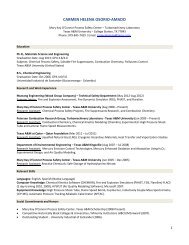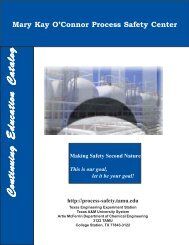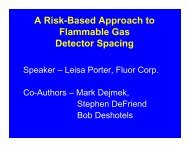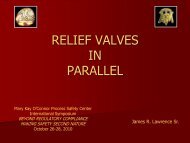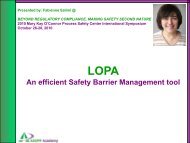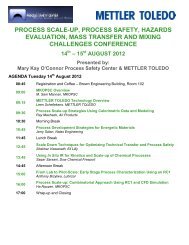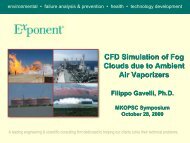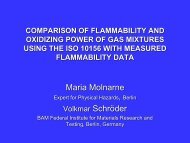bayesian-lopa-method.. - Texas A&M University
bayesian-lopa-method.. - Texas A&M University
bayesian-lopa-method.. - Texas A&M University
Create successful ePaper yourself
Turn your PDF publications into a flip-book with our unique Google optimized e-Paper software.
OUTLINE OF RESEARCHBayesian-LOPA Methodology Development for LNG IndustryGeun Woong Yun, <strong>Texas</strong> A&M <strong>University</strong>In order to meet the fast growing LNG (Liquefied Natural Gas) demand, manyLNG importation terminals are operating currently. Thus, it is important to estimate thepotential risks in LNG terminals with LOPA (Layer of Protection Analysis) which canprovide quantified results with less time and efforts than other <strong>method</strong>s. For LOPAapplication, failure data are essential to compute risk frequencies. However, the failuredata from the LNG industry are very sparse and have statistically shake grounds.Therefore, Bayesian estimation, which can update the generic data with plant specificdata, was used to compensate for its weaknesses.Based on Bayesian estimation, the frequencies of initiating events were obtainedusing a conjugate gamma prior distribution such as OREDA (Offshore Reliability Data)and Poisson likelihood distribution. If there is no prior information, Jeffreysnoninformative prior may be used. The LNG plant failure database was used as plantspecific information. The PFDs (Probability of Failure on Demand) of IPLs(Independent Protection Layers) were estimated with the conjugate beta prior such asEIReDA (European Industry Reliability Data Bank) and binomial distribution. In somecases, EIReDA did not provide failure data, so the newly developed Frequency-PFDconversion <strong>method</strong> was used instead. By the combination of Bayesian estimation andLOPA procedures, the Bayesian-LOPA <strong>method</strong>ology was developed and was applied toan LNG terminal. The found risk values were compared to the tolerable risk criteria tomake risk decisions and compared to each other to make a risk ranking. The Bayesian-LOPA <strong>method</strong>ology can be used in other industries. Furthermore, it can be used withother frequency assessment <strong>method</strong>s such as Fault Tree Analysis (FTA) and Event TreeAnalysis (ETA) to strengthen their results.
ivinformation because it provided the failure data made from beta distribution. In somecases EIReDA did not provide failure data, so the newly developed Frequency-PFDconversion <strong>method</strong> was used instead. By the combination of Bayesian estimation andLOPA procedures, the Bayesian-LOPA <strong>method</strong>ology was developed. The <strong>method</strong> wasapplied to an LNG importation terminal. For seven incident scenarios, it produced validrisk values. The posterior values of every initiating event or IPLs are located betweenprior and likelihood values. This means that the posterior values are valid and wellupdated.The found risk values were compared to the tolerable risk criteria given by CCPS(Center for the Chemical Process Safety) to make risk decisions. Finally, the estimatedrisk values of seven incident scenarios were compared to each other to make a riskranking in view of probabilistic risk analysis which considers only failure frequencywithout considering consequence analysis.In conclusion, as the good safety records of LNG industries speak, in thisresearch, it can be generally concluded that the LNG terminal has good safetyprotections to prevent dangerous events (see Figure 5). The newly developed Bayesian-LOPA <strong>method</strong>ology as one of the risk assessment <strong>method</strong>s really does work well in anLNG importation terminal and it can be applied in other industries including refineries,petrochemicals, nuclear plants, and aerospace industries. Moreover, it can be used withother frequency analysis <strong>method</strong>s such as Fault Tree Analysis (FTA) and Event TreeAnalysis (ETA).
vProcess informationProcess Flow Diagram, P&ID, Process DataProcess Hazard Analysis (PHA)HAZOPEstimate Consequence &SeverityCategory approachDevelop ScenariosFrom PHA resultsScenario : Initiating event + ConsequenceIdentify Initiating EventFrequencyIdentify Related IPLs &Estimating PFDs of IPLsBayesianEngineGeneric Data & Plant Specific DataIPL : Independence, Effectiveness,AuditabilityPFD of IPLs : Generic, plant specificdataEstimate Scenario FrequencyffciciJI= fi× ∏j = 1=fIi× PFDPFDi1i j× PFDi 2× .... × PFDiJRisk Ranking,Make Risk DecisionsRisk RankingCompare with tolerable risk criteriaRecommendations for SafetyEnhancementAdd IPLs or safety measuresFigure 3. The flow diagram of this research
viFrequency of initiating eventwith informative priorPrior distribution (frequency)Gamma distributionαβ α −1−λβf ( λ)= λ eΓ(α)αOREDA2 2μ μ= = γ2V σprior,prior2V σ= =μ μLikelihood function (probability)Poisson distribution−λtxe ( λt)Pr( X = x)=x!LNG facility failure datax : No. of failurest:timetofailureOREDA1( γ− ) α−1f ( λ)= λα eΓ(α)β = γ−1−1−λ(γ )BayesianEnginefpost∝ λ( x+α prior ) −1−λ(t+β prior )ePosterior distribution (frequency)Gamma distribution,αpost= x + αprior, βpost= t + βprior= t + 1/ γpriorMean of Posterior frequencyαpostx + αpriorx + αpriorμpost= = =β t + β t +1/ γpostpriorprior90% Bayes credible intervalλ = χ20.05( 2α) / 2β, λ χ20. 95(2α) / 2β0 .05post post 0.95=postpostFigure 4. The schematic diagram of Bayesian estimation for initiating events
viiComparison of scenario risk1.00E+001.00E-01Prior Likelihood Posterior1.00E-021.00E-03frequency (/year)1.00E-041.00E-051.00E-061.00E-071.00E-081.00E-091.00E-101.00E-111.00E-121.08E-052.60E-061.48E-072.45E-084.43E-116.01E-053.03E-053.16E-071.35E-071.43E-091.08E-094.54E-111.37E-052.90E-062.80E-079.87E-081.88E-096.86E-11scenario 1scenario 2scenario 3scenario 4scenario 5scenario 6scenario 71.00E-131.00E-141.48E-145.50E-14Figure 5. The risk value graphs of seven incident scenarios from an LNG terminal



